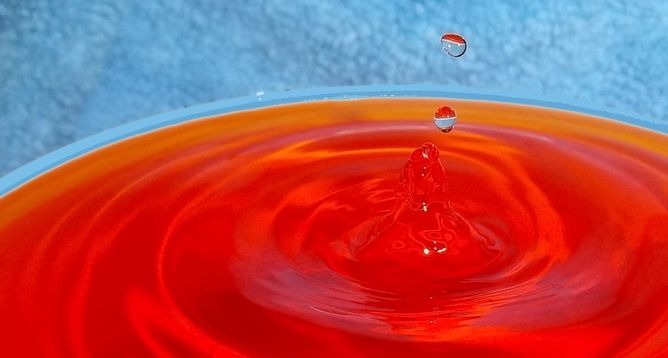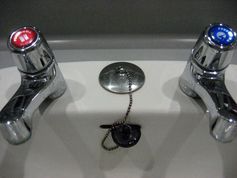
Is Red Warmer Than Blue? What Colours Can Tell You (Op-Ed)

This article was originally published at The Conversation. The publication contributed the article to Live Science's Expert Voices: Op-Ed & Insights.
In a typical kitchen or bathroom you often find the hot and cold water taps labelled red and blue.
It’s common practice in industrial and interior design in many parts of the world to present information about temperature by means of colour cues. People often talk about painting a room in warm hues such as yellows and oranges.

This association of a colour with a temperature is known as “crossmodal correspondence” and has been known about for many years.
But why do we make these associations? Are they learned just because that’s the way hot and cold have always been labelled, or is there some deeper association?
Much of the earlier research on this has been subjective and focused on asking people to rate colour patches or coloured stimuli as being either warm or cool, or by giving people a thermal stimulus and asking them to report which colour they were reminded of.
We wanted to examine the colour-temperature correspondence using more objective measures, and the results were published last month in PLoS ONE.
Sign up for the Live Science daily newsletter now
Get the world’s most fascinating discoveries delivered straight to your inbox.
The colour temperature test
We used a number of tests including an Implicit Association Test (IAT). The IAT is designed to assess the strength of automatic associations between different concepts in a given individual. (You can take a test yourself here if you’d like.)
A total of 42 people from Japan and Australia were run through one of three experiments. We manipulated the combination of colour and thermal stimuli presented in each trial.
In two experiments, the thermal stimuli were words such as “cold” or “warm” presented on a computer screen. In the third experiment people could feel a “warm” or “cold” stimulus on the skin of their index finger using a Peltier device.
In half of the trials people were shown congruent combinations (they were asked to associate red and warm) while in the other half of the trials people were shown incongruent combinations (this time they were asked to associate red and cold).

The results of our IAT confirmed our prediction that congruent pairings would give rise to shorter response times than incongruent pairings. This shows that the speed of response to a colour or a thermal word is influenced by the colour-temperature correspondences.
A one way effect
Some of the results also show that this colour-temperature correspondence might only work one way. Specifically, there was no difference in response times between congruent and incongruent pairs when people were identifying the colour of a stimulus in the pair.
But when people were asked to identify a temperature, the congruent pairings gave rise to shorter response times than incongruent pairings. People were quicker at identifying a “warm” stimulus when it was combined with red, relative to a “warm” stimulus paired with blue.
This asymmetrical effect is not unexpected given that colours are often used to indicate temperature, whereas temperature is seldom (if ever) used to indicate colour.
The colour of sound
A similar one-directional effect is seen in people who have a condition known as synaesthesia. They often perceive numbers, months or even sounds as colours; but fail to perceive colours as sounds, for example.
The correspondences between colour and temperature are presumably based on our natural observation of the environment around us with correlations that are likely learnt through experience.

Fire and the sun are both warm; hence all the colours of fire and the sun might be associated with warmth. Water and forests are cool; hence blue and green may be associated with coolness.
The association might also be linked to the fact that our skin gets redder when we are warm and blue when we are very cold.
It’s also been argued that many other crossmodal correspondences are based on natural, rather than learnt, correlations present in the environment, such as sound pitch and size. Large falling objects usually land with a deep thud, whereas smaller objects are more likely to make a high-pitched “ping” as they hit the ground. The calls of small animals are usually high-pitched relative to their larger counterparts.
So the reason we use red for the hot tap and blue for the cold tap is explained by our objective test. This crossmodal association is likely learnt via our encounters with colours and temperatures that correlate in the natural world. It also explains why we are slower to react when the colour combinations are reversed (such as hot and blue).
Cultures
In those cases where the crossmodal association is learnt through experience, different cultures and environments could possibly influence the colour-temperature association.
Our tests were done on people in Australia and Japan, and bathroom/kitchen taps in Japan are tagged with the same red (hot) and blue (cold) as they are in Australia, so our results were consistent for the colour-temperature association.
But in some African countries the association is reversed with blue signifying hot and red cold. Given the natural observed association of colour and temperature described earlier, it would be interesting to see if our test would produce different results in such countries.
George Van Doorn does not work for, consult to, own shares in or receive funding from any company or organisation that would benefit from this article, and has no relevant affiliations.
This article was originally published on The Conversation. Read the original article. Follow all of the Expert Voices issues and debates — and become part of the discussion — on Facebook, Twitter and Google +. The views expressed are those of the author and do not necessarily reflect the views of the publisher. This version of the article was originally published on Live Science.












